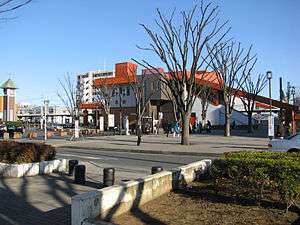Toro Station
Toro Station (土呂駅, Toro-eki) is a railway station on the Tōhoku Main Line (Utsunomiya Line) in Kita-ku, Saitama, Saitama Prefecture, Japan, operated by East Japan Railway Company (JR East).
Toro 土呂駅 | |
|---|---|
 Toro Station, April 2008 | |
| Location | 1-14 Toro, Kita-ku, Saitama-shi, Saitama-ken (さいたま市北区土呂町一丁目14) Japan |
| Operated by | |
| Line(s) | ■ Utsunomiya Line |
| Platforms | 1 island platform |
| Connections |
|
| History | |
| Opened | 1985 |
| Traffic | |
| Passengers (FY2014) | 13,966 daily |
Lines
Toro Station is served by the Tohoku Main Line (Utsunomiya Line) and the Shōnan-Shinjuku Line, and lies 33.3 kilometers from the starting point of the Tohoku Main Line at Tokyo.
Station layout
This station has an elevated station building with one island platform underneath.
Adjacent stations
| « | Service | » | ||
|---|---|---|---|---|
| Utsunomiya Line | ||||
| Commuter Rapid: Does not stop at this station | ||||
| Rapid Rabbit: Does not stop at this station | ||||
| Ōmiya OMYJU07 |
Local & Rapid Acty | Higashi-Ōmiya | ||
| Shōnan–Shinjuku Line | ||||
| Rapid: Does not stop at this station | ||||
| Ōmiya OMYJU07 |
Local | Higashi-Ōmiya | ||
History
Toro Station opened on 1 October 1983. With the privatization of JNR on 1 April 1987, the station came under the control of JR East.
Passenger statistics
In fiscal 2014, the station was used by an average of 13,966 passengers daily.[1]
Surrounding area
- Saitama City, Kita-ku Ward Office
- Toro Nishi-guchi Post Office
gollark: Yes, mocking things is fun.
gollark: That doesn't mean you can't *dislike* censorship by private companies even if they're allowed to do it legally.
gollark: Strictly speaking most free speech laws are about government restriction of speech, yes.
gollark: That would basically make them completely non-credible in the eyes of Trump-supporting types.
gollark: There are other ideas, like direct democracy and liquid democracy, but most places run on representative democracy.
See also
References
- 各駅の乗車人員 (2014年度) [Station passenger figures (Fiscal 2014)] (in Japanese). Japan: East Japan Railway Company. 2015. Retrieved 2 March 2016.
- Ishino, Tetsu; et al., eds. (1998). 停車場変遷大事典 国鉄・JR編 [Station Transition Directory - JNR/JR] (in Japanese). II. Tokyo: JTB Corporation. p. 392. ISBN 4533029809.
External links
| Wikimedia Commons has media related to Toro Station. |
- JR East station information (in Japanese)
This article is issued from Wikipedia. The text is licensed under Creative Commons - Attribution - Sharealike. Additional terms may apply for the media files.